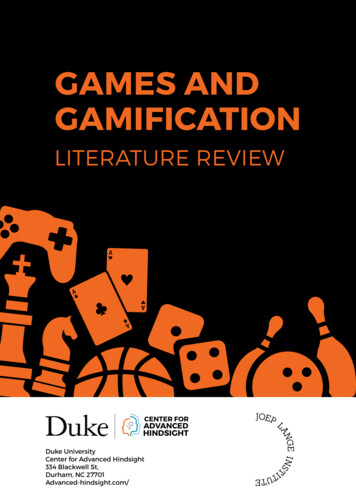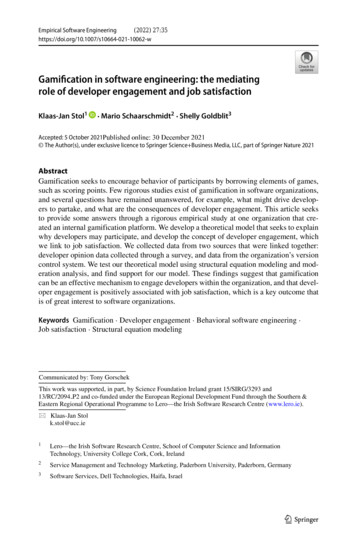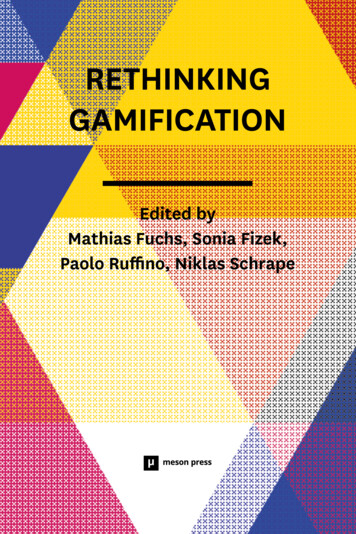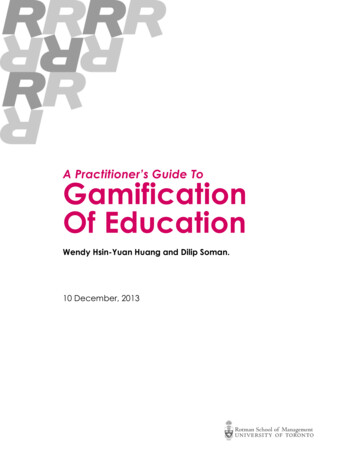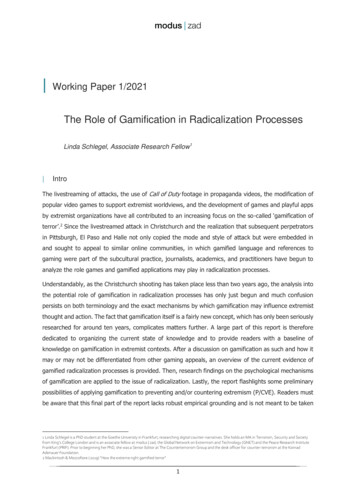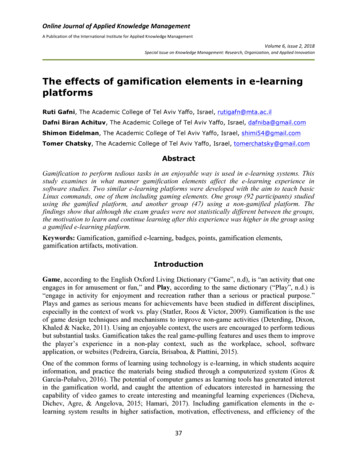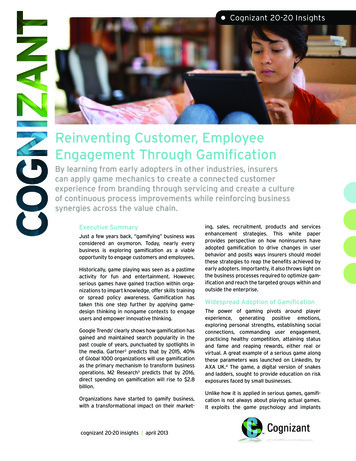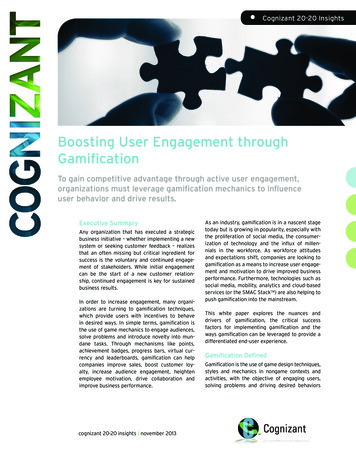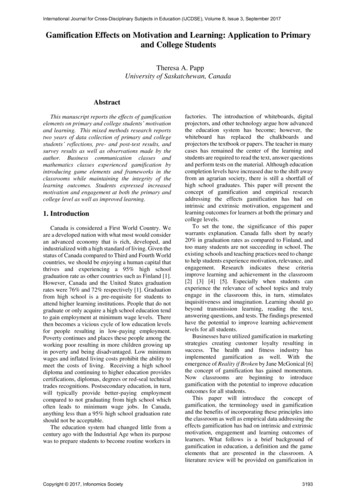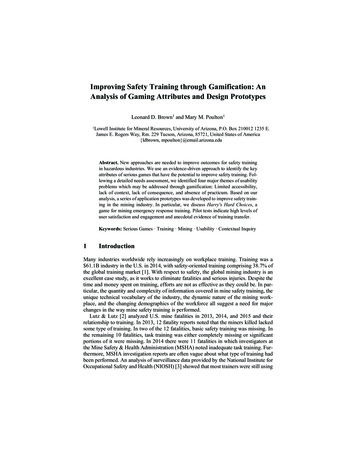
Transcription
Improving Safety Training through Gamification: AnAnalysis of Gaming Attributes and Design PrototypesLeonard D. Brown1 and Mary M. Poulton11Lowell Institute for Mineral Resources, University of Arizona, P.O. Box 210012 1235 E.James E. Rogers Way, Rm. 229 Tucson, Arizona, 85721, United States of America{ldbrown, mpoulton}@email.arizona.eduAbstract. New approaches are needed to improve outcomes for safety trainingin hazardous industries. We use an evidence-driven approach to identify the keyattributes of serious games that have the potential to improve safety training. Following a detailed needs assessment, we identified four major themes of usabilityproblems which may be addressed through gamification: Limited accessibility,lack of context, lack of consequence, and absence of practicum. Based on ouranalysis, a series of application prototypes was developed to improve safety training in the mining industry. In particular, we discuss Harry's Hard Choices, agame for mining emergency response training. Pilot tests indicate high levels ofuser satisfaction and engagement and anecdotal evidence of training transfer.Keywords: Serious Games · Training · Mining · Usability · Contextual Inquiry1IntroductionMany industries worldwide rely increasingly on workplace training. Training was a 61.1B industry in the U.S. in 2014, with safety-oriented training comprising 38.7% ofthe global training market [1]. With respect to safety, the global mining industry is anexcellent case study, as it works to eliminate fatalities and serious injuries. Despite thetime and money spent on training, efforts are not as effective as they could be. In particular, the quantity and complexity of information covered in mine safety training, theunique technical vocabulary of the industry, the dynamic nature of the mining workplace, and the changing demographics of the workforce all suggest a need for majorchanges in the way mine safety training is performed.Lutz & Lutz [2] analyzed U.S. mine fatalities in 2013, 2014, and 2015 and theirrelationship to training. In 2013, 12 fatality reports noted that the miners killed lackedsome type of training. In two of the 12 fatalities, basic safety training was missing. Inthe remaining 10 fatalities, task training was either completely missing or significantportions of it were missing. In 2014 there were 11 fatalities in which investigators atthe Mine Safety & Health Administration (MSHA) noted inadequate task training. Furthermore, MSHA investigation reports are often vague about what type of training hadbeen performed. An analysis of surveillance data provided by the National Institute forOccupational Safety and Health (NIOSH) [3] showed that most trainers were still using
didactic (i.e. lecture-based) methods, which research has shown to be of limited effectiveness [4]. Peters, Vaught, & Mallett summarize the situation:“Collectively, our nation’s miners sit through millions of hours of mandated S&Htraining each year, and mining companies spend millions of dollars to provide thistraining. Unless effective training materials and methods are used, miners are unlikelyto learn what they need to know to actually help reduce their risk of suffering occupational injury and illness. Many miners sit through the same training lectures and filmsyear after year in order to fulfill the requirements of the law. In these situations, their‘training’ ends up being a very unfortunate waste of time and resources i.e., a wastedopportunity” Peters, Vaught, & Mallett [5].Salas et al. [6] find that “properly designed training works and the way training isdesigned, delivered and implemented can greatly influence its effectiveness." A largebody of research has been published on strategies to improve learning for various typesof occupational training [7], [8], [9], [10]. Serious games are increasingly being usedfor training in fields ranging from medical science to homeland security. Building uponwork by NIOSH to use gamification for underground mine map reading training [11],we have pursued an in-depth study of serious games for safety training. In this article,we identify major usability problems in mine safety training and discuss our preliminary work to address those problems using serious games.2Related WorkA major goal in designing serious games is to identify the specific attributes and capabilities that will enhance learning. An overwhelming variety of game attributes and design patterns have been identified. For example, Garris, Ahlers, & Driskell [12] suggested that six key attributes are necessary: Fantasy, rules/goals, sensory stimuli, challenge, mystery, and control. Wilson et al. [13] expanded these six to include adaptation,assessment, conflict, interaction (equipment, interpersonal, social), language/communication, location, pieces/players, progress and surprise, representation, and safety.Other researchers have proposed similar collections of attributes [14], [15], [16], [17].Although an exhaustive survey is not possible due to space considerations, we outlinesome key attributes of serious games relevant to this work.Challenge. Challenge relates to the level of difficulty inherent in a game. Hays [18]listed challenge as a major factor contributing to user enjoyment and argued that challenge results from uncertain outcomes. Uncertainty can be designed into a game byusing multiple levels of goals, hidden or incomplete information, and randomness [18],[19]. Furthermore, research suggests a need for an optimal level of challenge-- that is,a balance between game play that is too easy and game play that is difficult [12]. Wilsonet al. [13] hypothesized that, "As the challenge feature in a game increases, so willdeclarative knowledge and learner’s retention of that knowledge. However, a point willbe reached when too much challenge will hinder and decrease learning (i.e., an invertedU relationship)."Fantasy. Fantasy, as defined by Wilson et al. [13], is a “make-believe environment,scenario, or characters. It involves the user in mental imagery and imagination.andanalogies for real-world processes. The user is required to take on various roles in whichthey are expected to identify." Activities in the game environment allow users to
explore situations that are detached from daily realities [12]. The fantasy world canmodel specific parts of the real world as necessary to meet game objectives. Fantasiesallow users to assume different roles and explore different mindsets [9]. Garris, Ahlers,& Driskell [12] suggested that "material may be learned more readily when presentedin an imagined context that is of interest than when presented in a generic or decontextualized form."Flow. An appealing aspect of serious games rests in their ability to engage an audience. Csikszetmihalyi [20] describes a state in which "people become so involved inwhat they are doing that the activity becomes spontaneous, almost automatic; they stopbeing aware of themselves as separate from the actions they are performing." For thisstate, Csikszetmihalyi [20] suggested the notion of flow as an optimal experience thatmerges individuals' actions with activity. Furthermore, Hays [18] described flow as asense of enjoyment, where "one 'loses' oneself in the activity." Research suggests thatachieving a "flow state" may have significant advantages for learning in both the shortterm and long term [21], [22].Rules. Game rules define the structure, boundaries, and goals of a game [12]. Rulesmay be aligned with reality or completely artificial, depending on the circumstances ofthe game. Garris, Ahlers, & Driskell [12] noted that “goals should be clearly specified,yet the possibility of obtaining that goal should be uncertain. Games should employprogressive difficulty levels, multiple goals, and a certain amount of informational ambiguity to ensure an uncertain outcome.”Assessment. We define assessment as a measure of achievement within a game [13].It is enabled by the tracking of in-game activities. A cycle of practice, re-teaching, andrevision can be used to create embedded assessments in which students are engaged inthe content and achievement is improved [23]. In particular, Gee [14] suggested thatgames allow users to engage in "reflective practice," through a four-step cycle of probing, hypothesizing, reprobing, and rethinking. Shute et al. [23] described an ideal situation that called "stealth assessment," in which the embedded assessments are "so seamlessly woven into the fabric of the learning environment that they are virtually invisible."3Field StudiesA major goal of this work was to identify the endemic usability problems of safetytraining. As a first step, we conducted a three-year, comprehensive field study of currenttraining pedagogy. Our objectives were two-fold: First, we wanted to gain a holisticview of training -- how the individual parts of the training regimen came together toshape the miners' understanding of safety; second, we wanted to examine the protocols,data sets, and flow of information that workers experienced.Our field studies employed a data-driven method called Contextual Inquiry (CI),which is the first step in a usability engineering process called Contextual Design [24].As a participatory design process, CI immerses a multi-disciplinary team of experts inthe application domain, allowing them to closely engage with end users and see problems from the users' points of view. Each field study involved three stages. In the firststage, our research team participated in each of the training activities as a form of apprenticeship. The second stage involved observation, in which we watched the
interactions between trainers and students in the classroom without disrupting the natural flow of their activities. Observation periods generally ran from 4 to 6 hours at atime. The third stage was an open-ended debriefing, in which we interviewed both students and trainers. Many of our questions were prompted either by our personal experiences during apprenticeship and our observations in stage 2.The mining industry is regulated by Title 30 of the U.S. Code of Federal Regulations(CFR), which directs MSHA to oversee all mining activities in the United States. TheCFR Title 30, Parts 46 and 48, outlines safety training requirements, including coursesfor new miners, annual refreshers, and newly hired experienced miners. At least 27topics are specified for each of these courses, although there is substantial overlap incontent. Note that compliance is based on seat time alone. As it was impractical toperform Contextual Inquiry on all of the required training topics, we selected a subsetin consultation with a panel of industry experts in mine safety. Representative activitieswere selected to include didactic training (e.g. lecture-based with slides), simulationsoftware, and training videos, for the following: Introduction to the Workplace. New and experienced miner training courses mustinclude an introduction to the work environment. Mine sites are complex and dynamic, so training activities must include tutorials on mine structure, methods, equipment, maps, and terminology. Situational Awareness. A survey of mine fatalities suggests that many accidents involve similar workplace hazards and risk-taking behaviors. As a result, there are numerous training topics which emphasize situational awareness. Specific training activities included surveying fatal accidents, recognizing hazards, and identifying mitigation strategies. Emergency Preparedness. Potential emergencies can result from a variety of events,such as explosions, fires, inundation, and ground falls. Emergency preparednesstraining is a two-part process that involves both generic classroom instruction andsite-specific drills. Each mine must also maintain a first responder team which isrequired to conduct monthly refreshers.4Usability ThemesContextual Inquiry [24] uses a data-driven discovery process to quantify the designspace and identify significant usability problems. In our case, CI allowed us to transform a collection of field study observations and measurements into a hierarchicalmodel, called an Affinity Diagram, which suggested some of the most significant obstacles to mine safety training. This analysis served as a starting point for designingmore effective training through serious games.4.1Empirical EvidenceIn our field studies, we collected a large body of empirical evidence. In particular, threetypes of evidence were collected:
Observations. Observations were collected during the apprenticeship and "pure observation" phases and were based on events that were directly apparent and requiredno interpretation. Examples include "Text on slide is hard to see" and "No explanation given for technical terminology." Note that observations may or may not haverelated comments or inferences. Comments. Comments represent a direct form of user feedback. Comments consistedof verbal and written quotes obtained during the debriefing session. They illustrateusers' opinions outright. Examples include "The instructions were confusing" and"We do it differently at my site." Where feasible, comments were collected fromboth trainers and trainees. Inferences. Inferences stem from observations that led to specific lines of questioning in the post-session debrief. They are based on the interpretations of our researchteam and further validated by user feedback. Inferences are valuable because theyoffer deeper insight into the user experience and can suggest causality. Examplesinclude "The user is visibly frustrated that he cannot find his way" and "Dealing withcomputer interface distracted user from task goal."Over one thousand pieces of evidence were collected in our three field studies.Through an aggregation process, we then reduced the evidence to 473 discrete datapoints. Aggregation involved eliminating duplicate data, such as observations that wererecorded by different members of the team for the same application, coalescing similarinferences into one interpretation, and removing multiple instances of analogous usercomments which might have slightly different wording. However, we did not eliminateobservations, inferences, or comments that were similar if they occurred in multiplefield studies, as this would have diminished the strength of the evidence.4.2Affinity DiagramBased on the three types of evidence that we collected, an Affinity Diagram [24] wasconstructed to identify the major themes of usability problems. The diagram is builtinductively from the ground up; similar evidence is recursively grouped together andlabeled. The diagramming process results in a hierarchy of problem categories whichat the top level identifies the principal themes of usability problems. Note that a pieceof evidence may be placed into more than one grouping as necessary. A strength of theAffinity Diagram is that it does not use preconceived groups; the problem categoriesarise spontaneously based on the intrinsic structure of the evidence. The number ofpieces of evidence in a category also suggests the frequency of the problem.The abridged Affinity Diagram may be found in Fig. 1. For brevity, the diagramomits the individual pieces of evidence that were used to derive its structure; theabridged diagram represents the top three levels of the hierarchy. Our analysis suggeststhat there are 45 specific usability problems in safety training (bottom level of chart).The mean was 10.47 data points, with a standard deviation of 4.21, per usability problem. Together, these 45 specific problems illustrate 17 major categories (mid-level).We have further grouped the 17 major categories into 4 usability themes for safetytraining (top level):
LIMITED ACCESSIBILITYObstacles to acceptanceLACK OF CONTEXTMedia do not meet needs of taskThe age gapProblems with computer mediaAversion to (new) technologyProblems with print & other mediaThe time it takesErgonomic risk factorsBeyond the user's skill setDifficult tasksCognitive overloadLack of remediationLimited language & workplace literacyA multi-lingual audienceDetails do not meet needs of taskMissing or unavailable dataToo little detailToo much detailLack of spatial awarenessLimited point of viewDisorienting workplace structureUsers cannot relateLimited language understandingStylized or abstractPresumption of workplace literacyLack of real world examplesVariation across work sitesUnauthentic usage of equipmentDifficult for novice usersApparent learning curveThe need for technology tutorialsA multitude of standardsLack of concise mechanicsClumsy context switchesOverly limited interface mechanicsArtificial constraintsNecessity of tactile feedbackABSENCE OF PRACTICUMInadequate storyStandardized contentBelievable deliveryLack of motivationBoredom among usersUsers as competitorsFew opportunities for crew interactionImportance of team activitiesLACK OF CONSEQUENCESNo cause-and-effectUnclear rules and boundariesConfusing timelines and eventsScenarios that are static or inflexibleFew opportunities for teamworkHard to communicateVerbal communication problemsLack of workplace-specific formsNeed for hands-on experimentationNo workplace dynamicsFew chances to practice techniquesLack of hypotheticalsLack of substantive feedbackConfusion about task progressFew ways to evaluate competencyWhere do I go?What do I do?Fig. 1. Abridged Affinity Diagram. A hierarchical clustering of the evidence from our field studies suggests that there are four principal themes usability problems in mine safety training.
1. Limited Accessibility. Promote acceptance across a range of worker demographics,engaging a new generation of miners in addition to experienced miners. Accommodations should be made to address computer and workplace literacy issues and second language learners.2. Lack of Context. Provide a meaningful context and level of detail to illustrate important relationships. In particular, training must be grounded in the familiar, relatingnew concepts to each worker's experience.3. Lack of Consequences. Illustrate the consequences of choices. Workers require abetter understanding of timelines and causality if they are to recognize hazards andanticipate the outcomes of good and bad choices.4. Absence of Practicum. Emphasize story-driven scenarios and evaluation. Hands-onactivities reinforce learning and allow for the assessment of worker safety competencies.5Game PrototypesMany of the usability problems outlined above can be resolved through active learningtechniques [4] using well-designed serious games. In particular, we have developed asuite of computer-based video games for mine safety, including Harry's Hard Choices,which teaches mine emergency response. A thorough treatment of this game prototypeand several others may be found in Brown [25].5.1Harry's Hard ChoicesOur serious game Harry’s Hard Choices (HHC) has its inspiration in a series of NIOSHpaper exercises for mine emergency response, in which miners "role play" through adisaster story [26], [27]. This type of experiential training allows the miners to thinkabout options in a relevant context. However, the paper exercises do have substantiallimitations: They cannot give users a visceral experience that simulates the chaos of areal emergency; they are serialized based on the sanctioned answer to each question;they provide limited information about the emergency situation; and they cannot showcause-and-effect in response to users' free will.In HHC, the user assumes the role of a foreman tasked with evacuating his crew inthe face of a rapidly unfolding mine disaster (Fig. 2). Similar to the paper scenarios, ourgame is set in an underground coal mine and involves a mine fire. However, we havede-serialized the events of the paper scenarios and greatly extended them to create animmersive sandbox where users have free will to explore the environment, use equipment, and engage in a variety of crew-based interactions. Based on realistic situationsthat miners may face in an emergency, a diverse range of hazards has been added, including roof falls, expiring and defective respirators, inoperative refuge chambers,flammable gases, broken escape lines, and electrical faults. Story events can occur inparallel and there are many possible outcomes. They can also be randomized, so that adifferent sequence of events is presented each time the game is run.
Fig. 2. Harry's Hard Choices. Save a crew of miners (top) from an unfolding disaster featuringsmoke, fire, lethal gases, ground falls, faulty equipment, and many other hazards (bottom).5.2Game Attributes for Safety TrainingTo address the usability themes discovered in our field studies, we sought motivationfrom best practices in games for entertainment. Entertainment games can be very effective at immersing users in complex virtual worlds where they must spend hours performing sophisticated tasks to achieve game goals. The best games sell millions of copies and maintain a user base for many years; consider The Elder Scrolls V: Skyrim.There are many design patterns that can make games more effective; a non-exhaustivesurvey may be found in [28]. We have cross-walked the usability themes for safetytraining with the game attributes that were found to be effective for learning (Sec. 2)and aligned them with design patterns for entertainment games. We then implementeda series of these design patterns in our prototype, HHC (see Table 1).As an example, consider the "Limited Accessibility" theme of Fig. 1. To addressproblems with user acceptance, we have applied design patterns that promote challengeand flow as outlined in Sec. 2. A set of game metrics was implemented, including ascoring system that awards or deducts points based on user decision making. A fatiguemetric models exposure and exertion, similar to "hit points" in games for entertainment.The crew of non-player characters (NPCs) is likewise affected; crew members may be
injured, incapacitated, or even die. A time metric models the sense of urgency appropriate to mine disasters; as such, time penalties are enforced for poor decisions andprocrastination, which can lead to unwinnable conditions as the situation deteriorates.Finally, a morale metric models the impact of users' decision making on the NPC crew.As morale decreases, non-player characters will become increasingly stressed and irritated, culminating in the NPCs abandoning the group. The intent of these design patterns is to draw users into the game and give them a vested interest in the welfare of thecrew that they are trying to save. Our preliminary user study, discussed below, suggeststhat the game metrics substantially increased users' engagement, compelling them totry again and again to improve their outcomes.Table 1. A sample of game attributes and design patterns for safety training.Usability Theme6Game Attribute(s)Design Pattern(s)1Limited AccessibilityChallenge,FlowGame Metrics2Lack of ContextFantasyEmergent Stories,Microworlds3Lack of ConsequencesRulesGame Traps4Absence of PracticumAssessmentGame MetricsPilot TestOur field studies suggest that user acceptance and engagement are core requirementsfor training transfer (see Fig. 1, "Limited Accessibility"), a conclusion that is supportedby prior research [12], [14], [22]. A pilot study of user acceptance was conducted usinga "beta" version of HHC. This was the first time that domain users participated in rigorously play-testing the game with open-ended interaction and full gamification (Table1). As such, the objective of the study was to get feedback on the experience, includingstory design, game metrics, and user interface. Our primary evaluation instruments included pre- and post-session questionnaires. The pre-session questionnaire covered userdemographics and prior experience with gaming. Our post-session questionnaireadapted questions from standard usability instruments for the testing of interactive systems [29], [30]. Seven-point Likert scales were used.A total of 12 users (N 12) participated in our 90-minute pilot study. In addition to8 students from the Dept. of Mining and Geological Engineering at the University ofArizona, 4 professional miners were solicited from a mine site in Arizona. Seven of ourusers indicated that they had completed a new miner training course. Eight users weremale and 4 were female, with a mean age of 28 years (range 18-56). The users reporteda diverse range of technology and gaming experience; 25% reported themselves as"gamers." As such, the users were given a 25 minute tutorial on the game objectivesand mechanics and then allowed to play for up to 45 minutes. Their objective was torescue as many crew members (up to 9) and obtain the highest score possible. Therewere no restrictions on game play, and users could restart at any time.
A summary of user feedback is shown in Fig. 3. Given the low sample size, we didnot run a statistical test for significance. Users' opinions of the game were very favorable on all but one metric, "Satisfying vs. Frustrating." This result was attributed to abug in the game's path-following algorithm that has since been corrected. Users alsoleft favorable comments, such as "Great simulation" and "Fun learning experience."Users mentioned that they were "Surprised by the level of accuracy," and added thatthe game was "Very real," with "lots of options." A notable question posed to userswas, "Would you be interested in playing this game again?" All 12 answered "Yes." Inearlier testing, user feedback had been lukewarm, with none of our earlier users indicating the affirmative. The difference in outcomes rests primarily on the addition ofgame design patterns outlined in Table 1. In our previous test, HHC had been implemented as a vanilla simulation, instead of a full-fledged gaming experience. Furthermore, game play observations suggested that users’ task performance and decisionmaking improved through subsequent runs of the game. For instance, users' results improved from 0 or 1 crew members evacuated in the first iteration to a mean of 3.80 (outof 9) on the best attempt, which was typically the last. Note that the scenario parameterschanged randomly on each run of the game to prevent ingExcitingvs.DullChallengingvs.EasyFig. 3. Pilot study results for user satisfaction, N 12 (higher is better).7ConclusionsThis work represents a multi-disciplinary effort to improve training in safety-focusedindustries. We have taken an in-depth look at the mining industry, and, based on threeyears of field studies, identified four major themes of usability problems. In particular,our studies suggest that user acceptance and engagement are of utmost concern in safetytraining. To address these usability problems, we propose to draw from lessons learnedin games for entertainment; that is, better use of gamification can lead to more effectivetraining and better outcomes. Consider our prototype, Harry's Hard Choices, whichdraws users into mine emergency response with a challenging game experience full ofrealistic happenings, temperamental coworkers, and imperfect outcomes. Pilot testssuggest a high level of user satisfaction, which is a pre-requisite for high acceptanceand engagement.
We are continuing our analysis of field study data with the goal of identifying designguidelines. We are also developing a suite of serious games that will provide effectivetraining and competency assessment, in a medium that encourages discussion of safetyculture. Harry's Hard Choices is now being deployed in industry training courses, andefficacy tests are under way. Although this work focuses on the mining industry, wehope that the insights and technologies developed here will be transferable to other industries where workplace safety is of principal concern.Acknowledgements. We thank Michael Peltier for his significant contributions to theserious games development. We also thank Eric Lutz, Aly Waibel, Michelle Lutz, andthe many industry experts who participated in our field studies. This work was supported by NIOSH award 1U60-OH010014, Science Foundation Arizona award SRG0330-08, and MSHA Brookwood-Sago awards BS-22468-11-60-R-4, BS-23833-1260-R-4, and BS-26353-14-60-R-4. The authors have disclosed a financial interest inDesert Saber, LLC to the University of Arizona. These interests have been reviewedand are being managed by the University of Arizona in accordance with its policies onoutside interests.References1. Pappas, C.: Top 10 e-Learning Statistics for 2014 You Need to Know, tistics-for-2014-you-need-to-know (2014)2. Lutz, M., Lutz, E.A.: The Future of Training in a Data-driven Mining Industry. In: SMEAnnual Meeting, Feb 24, 2016. SME, Phoenix, AZ (2016)3. McWilliams, L.J., Lenart, P.J., Lancaster, J.L., Zeiner J.R., Jr.: National Survey of the Mining Population: Part II Mines. U.S. Dept. Health & Human Services, CDC/NIOSH IC 9528,NIOSH Pub. 2012-153 (2012)4. Dale, E.: Audio-visual Methods in Teaching (3rd ed.). Dryden Press, New York (1969)5. Peters, R.H., Vaught, C., Mallett, L.: A Review of NIOSH & US Bureau of Mines Researchto Improve Miner's Health & Safety Training. In: Brune, J. (ed.) Extracting the Science: ACentury of Mining Research, pp.501–509. Society for Mining, Metallurgy & Exploration,Littleton, CO (2010)6. Salas, E., Tannenbaum, S., Kraiger, K., & Smith-Jentsch, K.: The Science of Training andDevelopment in Organizations: What Matters in Practice. Psychological Science in the Public Interest, 13(2), pp 74–101 (2012)7. Burke, L., Hutchins, H.: Training Transfer: An Integrative Literature Review. Human Resources Development Review, 6(3), pp. 263–296 (2007)8. Juul, J.: The Game, the Player, the World: Looking for a Heart of Gameness. In: Copier, M.,Raessens, J. (eds.) Proc. Level Up: Digital Games Research Conference, Utrecht, Netherlands, pp. 30–45 (2003)9. Malone, T.W., Lepper, M.R.: M
Improving Safety Training through Gamification: An Analysis of Gaming Attributes and Design Prototypes Leonard D. Brown1 and Mary M. Poulton1 1Lowell Institute for Mineral Resources, University of Arizona, P.O. Box 210012 1235 E. James E. Rogers Way,
